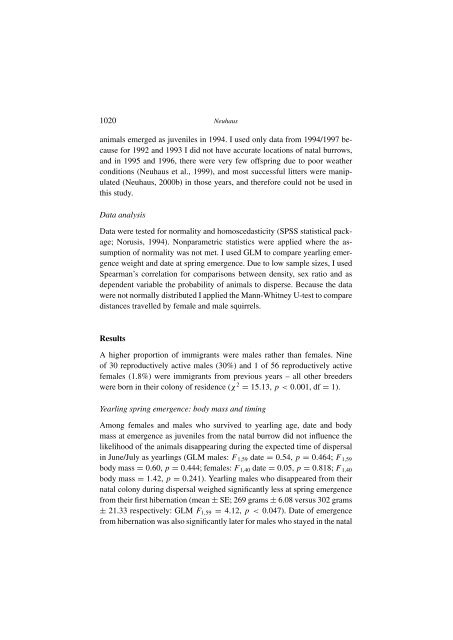Causes and consequences of sex-biased dispersal ... - ResearchGate
Causes and consequences of sex-biased dispersal ... - ResearchGate
Causes and consequences of sex-biased dispersal ... - ResearchGate
You also want an ePaper? Increase the reach of your titles
YUMPU automatically turns print PDFs into web optimized ePapers that Google loves.
1020 Neuhaus<br />
animals emerged as juveniles in 1994. I used only data from 1994/1997 because<br />
for 1992 <strong>and</strong> 1993 I did not have accurate locations <strong>of</strong> natal burrows,<br />
<strong>and</strong> in 1995 <strong>and</strong> 1996, there were very few <strong>of</strong>fspring due to poor weather<br />
conditions (Neuhaus et al., 1999), <strong>and</strong> most successful litters were manipulated<br />
(Neuhaus, 2000b) in those years, <strong>and</strong> therefore could not be used in<br />
this study.<br />
Data analysis<br />
Data were tested for normality <strong>and</strong> homoscedasticity (SPSS statistical package;<br />
Norusis, 1994). Nonparametric statistics were applied where the assumption<br />
<strong>of</strong> normality was not met. I used GLM to compare yearling emergence<br />
weight <strong>and</strong> date at spring emergence. Due to low sample sizes, I used<br />
Spearman’s correlation for comparisons between density, <strong>sex</strong> ratio <strong>and</strong> as<br />
dependent variable the probability <strong>of</strong> animals to disperse. Because the data<br />
were not normally distributed I applied the Mann-Whitney U-test to compare<br />
distances travelled by female <strong>and</strong> male squirrels.<br />
Results<br />
A higher proportion <strong>of</strong> immigrants were males rather than females. Nine<br />
<strong>of</strong> 30 reproductively active males (30%) <strong>and</strong> 1 <strong>of</strong> 56 reproductively active<br />
females (1.8%) were immigrants from previous years – all other breeders<br />
were born in their colony <strong>of</strong> residence (χ 2 = 15.13, p
















